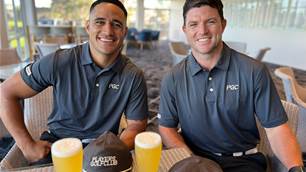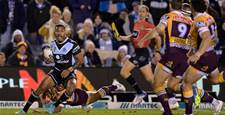As Billy Slater prepares for the final State of Origin game of his illustrious career, what can the Queensland Maroons legend share with us mere mortals about the occult art of fullback?
There’s a growing belief that 35-year-old Slater is the best fullback to have ever played the game. How’s that for a polariser - right up there with the best there’s ever been: Churchill, Langlands, Lockyer, Les Johns, Eadie, Barnes, Thornett, Carlson, McMillan and Charles “Chook” Fraser?
It can prove absolutely pointless comparing eras in an ever-changing game such as rugby league, but what we can do is analyse how Slater has grown into – again, arguably – one of the best-ever No.1s.
“The first time I played fullback was in the NRL,” Slater himself told Inside Sport magazine towards the end of the 2017 season. “It’s a position that just found me. I’d always played in the halves or at hooker growing up.
“When I went to Norths in Brisbane, the feeder club for the Melbourne Storm, I actually found myself playing in the centres. I played there and on the wing. I got the opportunity to come down to Melbourne. Robbie Ross got injured in the pre-season, therefore a spot came up at fullback. That was my position in my debut NRL game and I’ve pretty much played there ever since.”
The position found him – it’s a wonderful thought. “It’s a great position to play; it gives you so much freedom,” he gushes.
“In this day and age, where rugby league is so structured, I think fullback is the most free position you can play on the field. You’re not restricted to one side. You can roam around wherever, you can put on your own little plays, or you can chime in on others’. I feel very fortunate to be able to play that position.”
Slater’s development at fullback plotted along two main themes: work rate and positional play. Unlike fancy chip and chase movements, these aspects of the sport can’t be self-taught. Midway through Slater’s debut season in first grade back in 2003, Storm coach Craig Bellamy sat the young bloke down for a chat. The topic of conversation was the fullback at the Sydney Roosters.
“Anthony Minichiello was carrying the ball up 20-22 times per game at that stage,” Slater recalls. “My numbers were around ten. Although I’m a different style of fullback to Anthony, Craig didn’t expect me to have those sorts of numbers, he just wanted me to push towards them. He’d just challenge you with those little things during the year. Ultimately, that would make you a better player.”
“You probably need to be an all-round footballer these days to be a top-class fullback,” Slater offers. “It’s a position where firstly you need to be able to run the footy. That’s first and foremost. You need to be a threat when you’re running the football. Secondly you’ve got to nearly have the ball skills of a half and I think probably one of the other most important things is your communication skills have got to be really strong.”
At 178cm and 88kg, Slater is built for speed. Over the seasons, he’s been able to combine this important fullback element with his ball-playing ability and the confidence in his own skillset. Early in his career, he’d spot a defender out of place and press the detonate button and planet rugby league would explode into excitement. He produced that ridiculously good kick-and-chase try in State of Origin 14 years ago, if you can believe that.
He’s still scary-good, but experience means that today he’s more calculating and less chimpanzee-with-a-machine-gun with what he tries on the field. Bellamy painted it perfectly in Slater’s autobiography, released last year by Penguin Books Australia: “There is a scoreboard there that gives you a few clues; he respects the game situation more than he has in the past.”
“I do a lot of work with my wingers, making sure we’re in position,” says the veteran Billy Slater, who has clocked up over 300 NRL games for his beloved Melbourne Storm. “I demand them to be. I demand myself to be. If we’re doing that, we’re putting a lot of pressure on the kickers.
“The more times we can get to the ball on the full or as early as possible, it gives our team the best opportunity to start the set well. Especially in State of Origin, where the majority of the starts of sets come from kick returns. It’s just an integral part of the game.
“I’m in charge of the defence when I’m back there. You have to feel like you’re in charge. If you don’t, you’re probably not going to be talking to your players with the authority you need to. They’re really tired and they’re doing all the work in the middle.
“They need that firm direction to make sure they’re getting in the right position.
“They’re the things I really focus on; making sure I’m getting my defensive line in the right spot, and then chiming in to the defensive line when I need to. That’s probably the toughest role as a fullback, because you need to be able to work hard and get used to not getting a lot of reward.”
Originally published in Inside Sport magazine, September 2017 edition as “To Hell And Back”.
Related Articles

Viva Las Vegas: Join Golf Australia magazine's Matt Cleary on a golf and rugby league spectacular

19 Holes With ... Chad Townsend and Val Holmes













